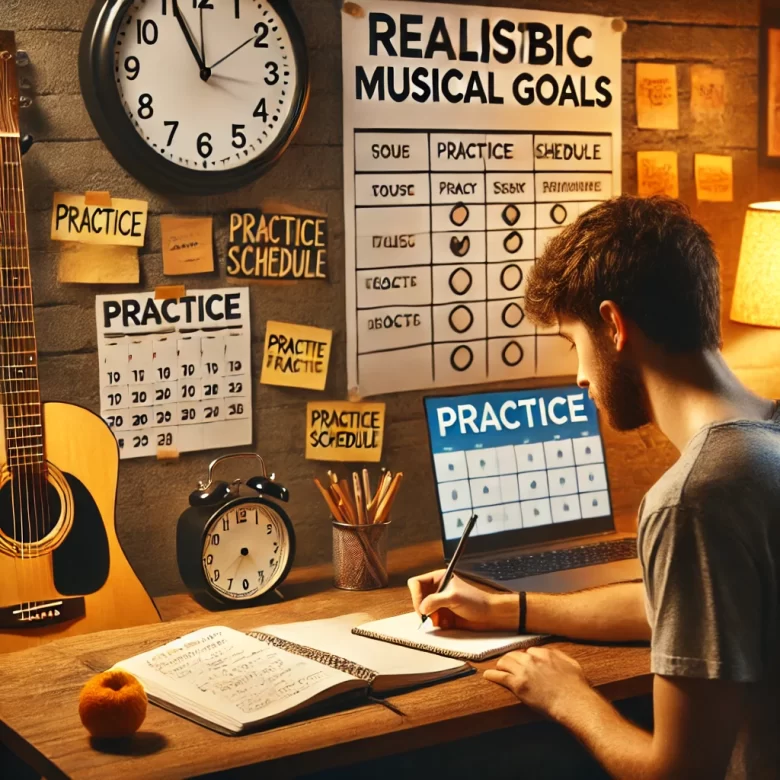Starting your musical journey is exciting, but it can also be challenging. Setting realistic goals is essential to stay motivated and ensure consistent progress. In this guide, you’ll learn how to define achievable objectives that will boost your music learning experience.
Why Setting Goals Matters in Music Learning
Having clear goals provides direction and purpose. They help you:
- Stay focused during practice.
- Measure progress over time.
- Overcome obstacles more easily.
- Build self-confidence as you accomplish small milestones.
Without defined goals, it’s easy to feel lost or demotivated. Many beginners stop playing because they feel they’re not improving—but often, it’s simply because they haven’t set goals that show visible progress.
What Makes a Goal “Realistic” for Beginners
A realistic goal is:
- Specific: “Learn three chords” instead of “Get better at guitar.”
- Measurable: You can track your progress.
- Achievable: Matches your current level and available time.
- Relevant: Aligned with your musical interests.
- Time-bound: Has a defined deadline.
Using the SMART method (Specific, Measurable, Achievable, Relevant, Time-bound) helps structure effective goals. It also ensures you focus on what’s most important for your development at each stage.
Step-by-Step: How to Set Your First Musical Goals
Choose Your Focus
Decide what you want to achieve:
- Technique: Improve finger dexterity.
- Repertoire: Learn specific songs.
- Theory: Understand scales and chords.
- Ear training: Recognize intervals, melodies, and harmonies.
Choosing one or two areas helps you avoid overwhelm and makes your learning more intentional.
Set Short-, Medium-, and Long-Term Goals
- Short-term: Practice 15 minutes daily for a week.
- Medium-term: Learn a simple song in a month.
- Long-term: Perform in a recital within six months.
Write these goals down. Seeing them on paper (or digitally) makes them feel more real and increases your commitment.
Break Down Big Goals into Micro-Tasks
Let’s say your medium-term goal is to learn a song. You can break it down into:
- Learn the chords in verse 1.
- Practice transitions between chords.
- Play along with a slow backing track.
- Record yourself and evaluate.
This method turns abstract goals into concrete steps you can take action on every day.
Tools to Help You Stay on Track
Use resources to monitor your progress:
- Practice apps: Like Yousician, Simply Piano, or GuitarTuna.
- Practice journals: Note what you practiced and for how long.
- Checklists: List skills or songs to learn.
- Progress charts: Track your improvement visually over time.
You can also schedule regular self-evaluations—once a month, review your progress and adjust your goals accordingly.
How to Adjust Goals as You Progress
If a goal feels too easy or too hard:
- Reevaluate: Adjust the goal to make it more challenging or accessible.
- Stay flexible: Changes are normal and part of the learning process.
- Celebrate achievements: Acknowledge and reward each milestone.
Life happens—sometimes you’ll have more or less time or energy. What matters most is continuing with intention and adjusting without guilt.
Common Mistakes When Setting Musical Goals — and How to Avoid Them
- Vague goals: Be specific about what you want to achieve.
- Unrealistic expectations: Set goals that match your level.
- No tracking: Regularly monitor your progress.
- Comparing with others: Focus on your own journey and improvement.
- Neglecting personal interests: Don’t set goals based only on what’s popular—learn what excites you.
Stay true to your interests and abilities, and your progress will feel natural and rewarding.
Final Thoughts: Small Wins, Big Results
Remember that each small step adds up to big accomplishments. Setting realistic goals keeps you motivated and on the right path. With dedication and well-defined objectives, your musical journey will be rewarding and successful.
The key is to start small, stay consistent, and celebrate every win—no matter how tiny. Over time, these little victories will lead to powerful musical growth and fulfillment.




